MARKETING
How to Avoid Duplicate Conversions and Recreating the Conversion Funnel for GA4
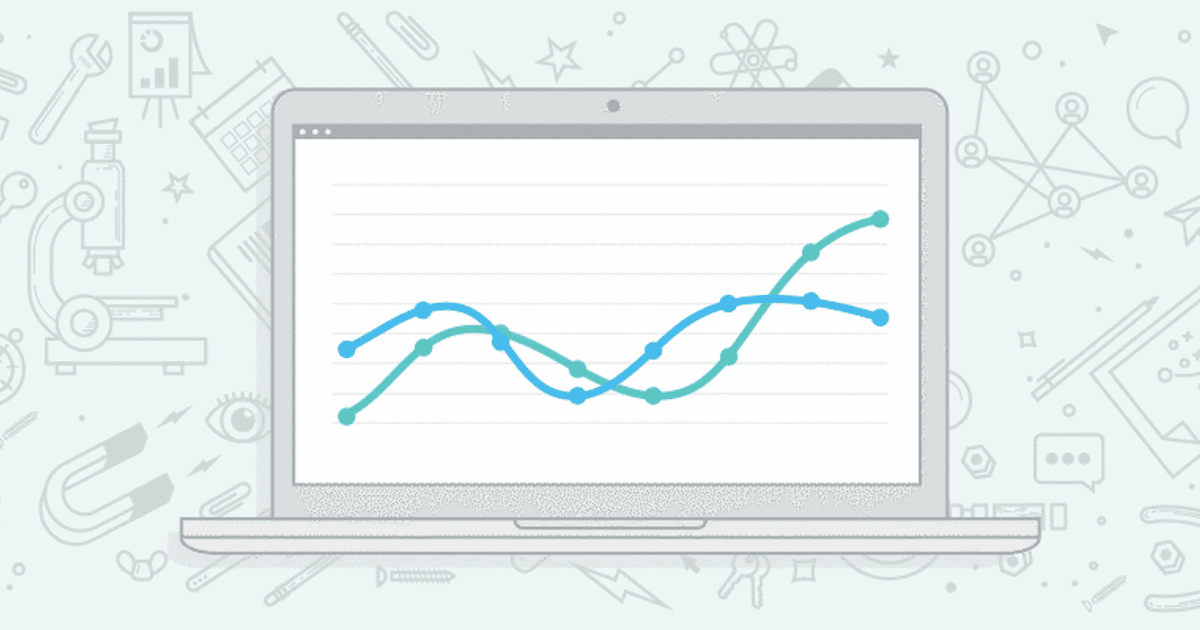
The author’s views are entirely his or her own (excluding the unlikely event of hypnosis) and may not always reflect the views of Moz.
As you’re probably all too aware at this point, GA4 is coming. Old versions of Google Analytics will be switched off for pretty much everyone come June 2023.
While GA4 is improving all the time, there are quite a few things that people are used to seeing in old versions of Analytics which, at the very least, take a bit of creativity in the new world.
One example is how conversions are handled. In the old versions of Google Analytics, a conversion could only fire once per session. In GA4 conversions are just another kind of event, so it’s possible for a conversion to fire multiple times in one session.
Problem is, you might be very interested if someone signs up via your contact-us form once. But that person might reload the thank-you page, or sign up for something else via a different form on the site. That doesn’t mean you necessarily want to track two conversions.
Speaking of signing up via different forms, on some websites, users may wind up on the same thank-you page having taken very different routes to get there. If we don’t have that much control, and we’re having to rely on thank-you page views to track conversions, it can be hard for us to separate out different kinds of conversions.
In old versions of GA you could use funnels with a “required” step. You might have one goal with a funnel requiring your event page, another goal with a funnel requiring a different page, and rely on them to give you different conversions. There also isn’t an obvious way to do this in GA4.
In this post, I’m going to take you through how to:
-
Avoid double counting in GA4.
-
Automatically ignore suspicious conversions (like people landing direct on the conversion page).
-
Recreate the kind of funnels we expected in Universal Analytics (in fact we’ll make them better).
I’ll take you through a few bits in GA4 and others using Google Tag Manager. The GA4 approach is more straightforward, but the Tag Manager is more robust and can help you make sure that all of your conversion pixels are showing roughly the same information (because we’re long past the point where GA is the only place we’re recording conversions).
Managing conversions in GA4
This section is about changes we can make purely through the GA4 interface. As long as you’re sending your page views conversion events to GA4 you should be able to use these tactics without any code changes.
However: There are some limitations of doing things through GA4, for example it can mean that your GA data doesn’t line up with conversions recorded via other platforms.
Avoiding double-counting
Julius Fedorovicius (of Analytics Mania fame) has produced a fantastic guide to making sure that conversions are only recorded once per session.
You should have a read but broadly:
-
You create a custom audience based on a sequence that begins with “session_start”
-
You fire an event when someone enters that audience
-
You use that event as your conversion.
No surprise that Julius has come up with a really smart way to handle the problem of double-counting:

If you’ve created Segments in Universal Analytics Audience sequences in GA4 look very like the sequences we used to create for Segments. However, the old Segments were just a way of visualizing data, whereas Audiences in GA4 are a way of grouping data. We can use Audiences to create something new.
That distinction is important because we can do cool things like fire custom events when someone enters an audience (which Julius makes use of in this solution).
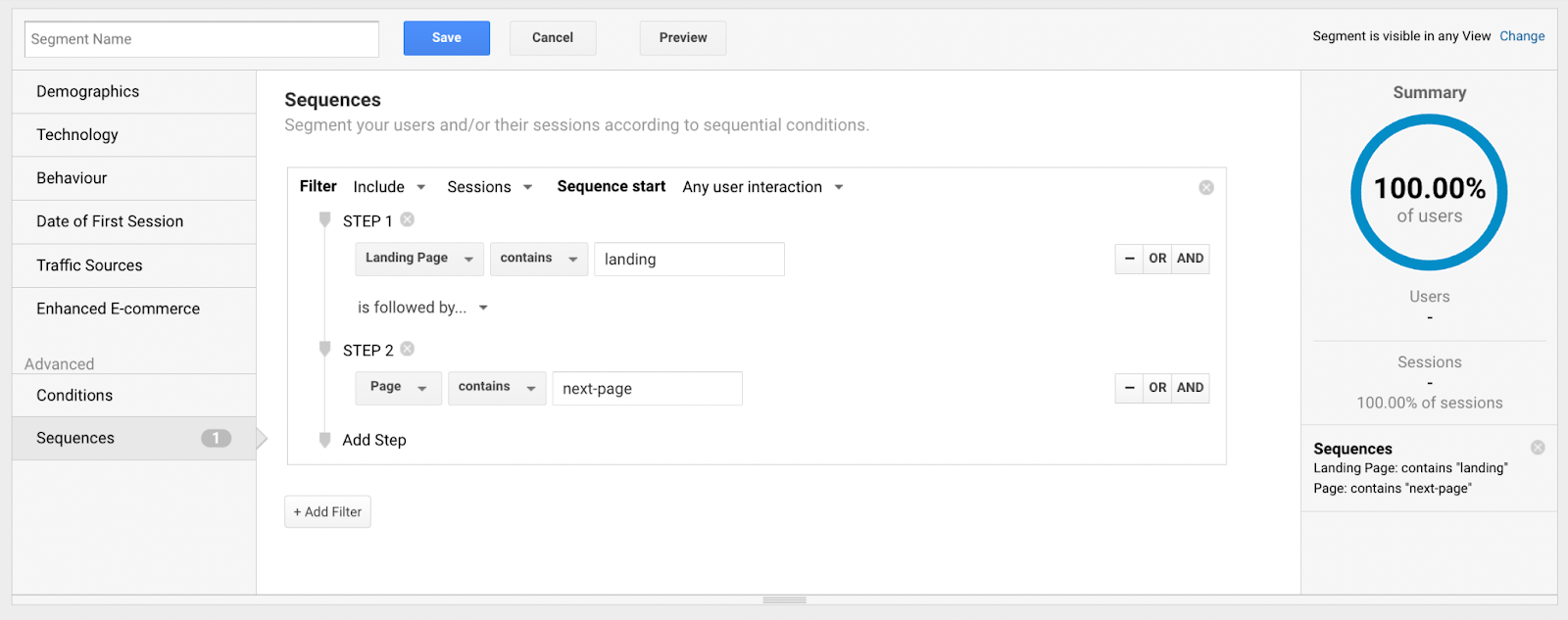
Universal Analytics Segment sequence creator
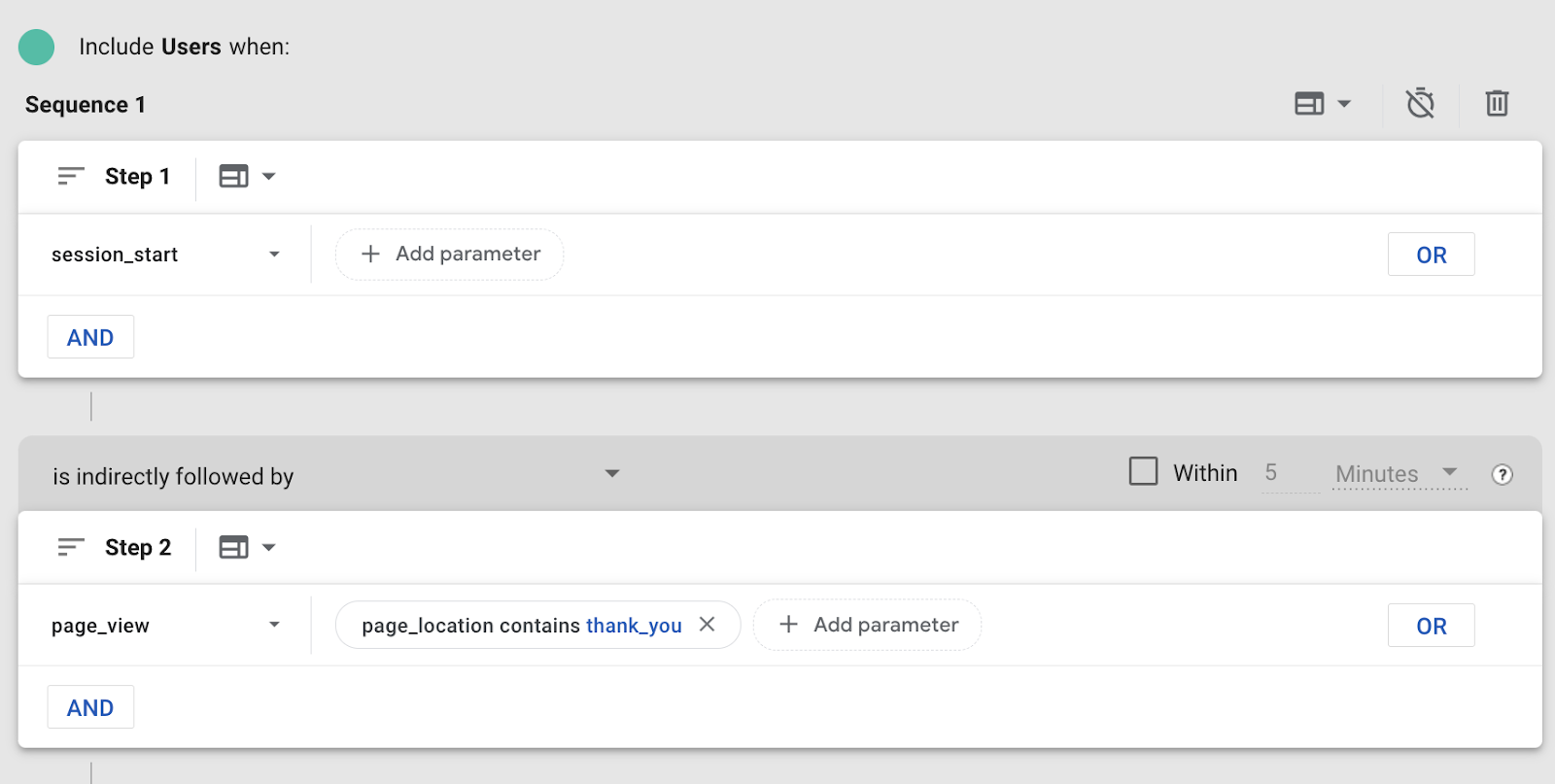
GA4 Audience sequence creator
The limitations of using Google Analytics audiences
This isn’t really a limitation as far as GA goes but it’s a consideration nonetheless. Julius’ solution is great for making sure we’re not double-counting conversions in GA, but GA probably isn’t the only way we’re recording conversions.
The average site probably has a bunch of separate conversion tracking pixels and those could end up double-counting conversions.
For example: Facebook and Google both describe how they avoid double-counting conversions, but their solutions largely rely on exactly matching transaction IDs, and even if they’re handling it okay, there’s a bunch of smaller fish out there that are also offering conversion tracking and can need a bit more hand-holding.
If we want to make sure that we’re only recording one conversion per session, it’s useful to make sure all of our conversion tracking is working in a similar way. Tag Manager is a great solution for that (I describe a solution in the Tag Manager section below).
You can also run into problems if, for example, your confirmation page is somehow indexed or bookmarked by users — people landing directly on it can lead to weird unexpected conversions. We can also use Tag Manager to guard against that a little bit.
Recreating the conversion funnel
Sticking with the GA4 interface for now, we can also adapt the AnalyticsMania approach to create our funnel-based conversions too by adding additional steps to the sequence.
For what it’s worth, conversion funnels are not the ideal way to categorize conversions. If you can use anything more direct (like the id of the form they’ve filled out, a separate thank-you page) then that’s a much more reliable way to categorize conversions. That said, we don’t live in a perfect world, and sometimes there isn’t the option to completely rebuild your conversion process.
In Fedorovicius’ example we just have two steps in our audience sequence:
-
Session_start
Indirectly followed by -
Conversion
Which basically means “someone lands on the site and then at any point during their session, they convert”.
To recreate the goal funnels you might be using in Universal Analytics – we can just add another step to the sequence. For instance:
-
Session_start
Indirectly followed by -
Visiting our event_page
Indirectly followed by -
Landing on our thank you page/converting
That should mean we can create one conversion which is: Users who went through our event page and then converted.
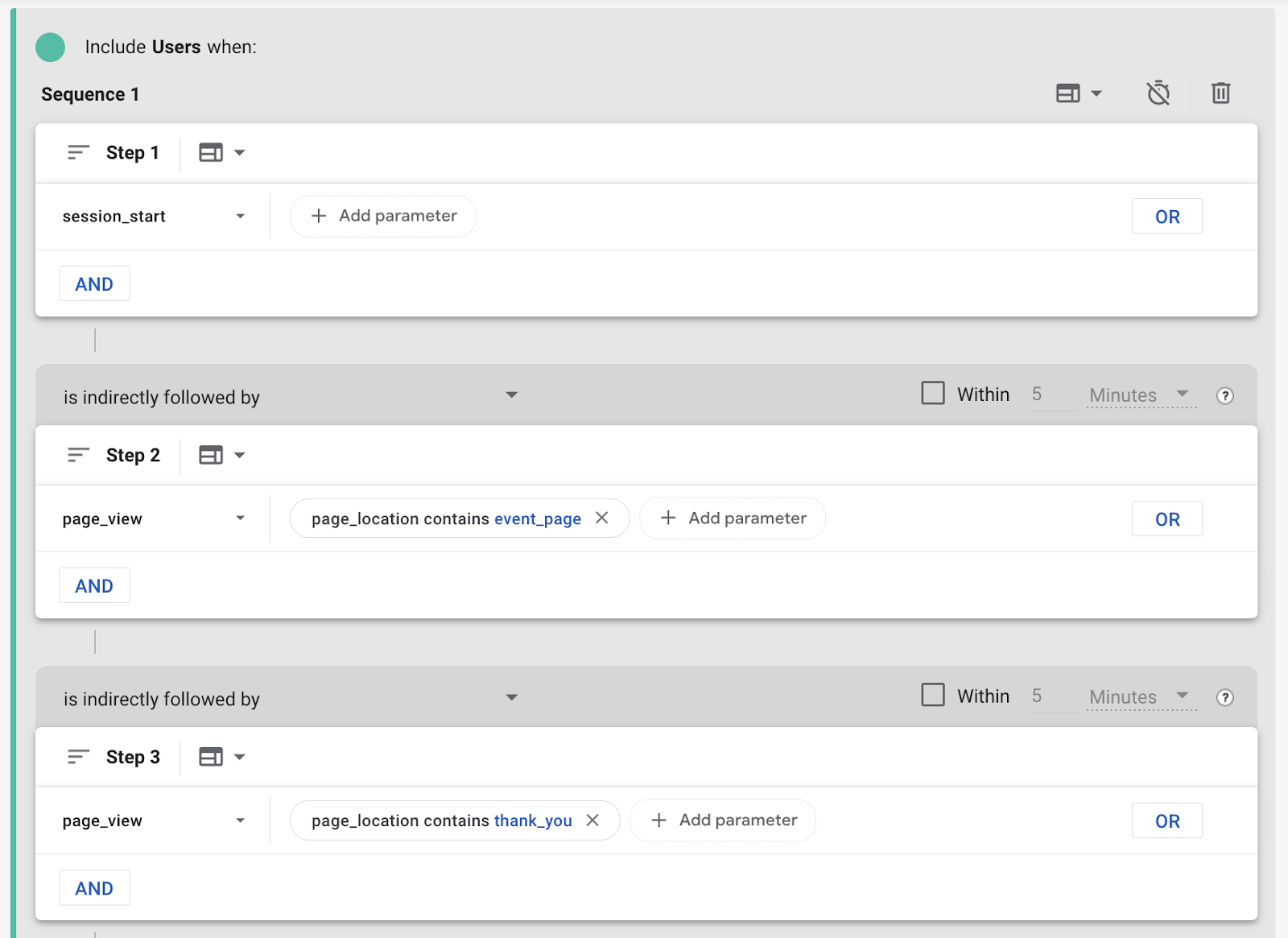
And another conversion which is: Users who went through our sponsorship page and then converted.
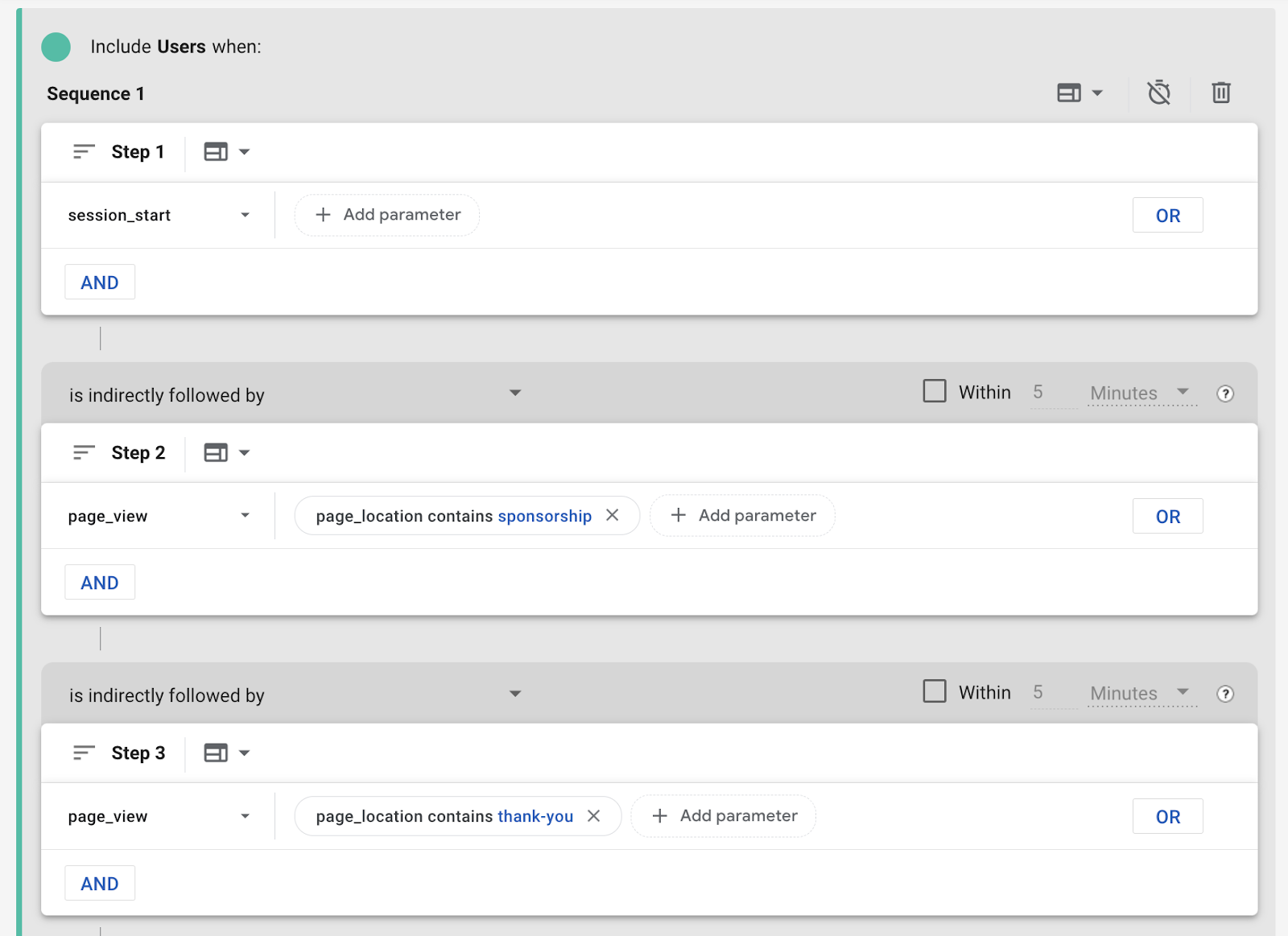
There are some limitations here though, for example, what if someone:
-
Landed on the site
-
Visited our event page
-
Then visited our sponsorship page
-
Converted using the form on either.
They would fulfill the criteria for our event conversion and the criteria for our sponsorship conversion. We’d record a conversion for each and we’d end up double-counting after all.
This is also a limitation of the old Universal Analytics funnels: Just because a step in the funnel was required doesn’t mean the user can’t wander off around the site between that step and their final conversion. So, if it’s any consolation, this isn’t any worse than old Universal Analytics funnels (but we can still do better).
The problem with using “directly followed by”
You might say “well that’s easily solved — at the moment the sequence says is indirectly followed by and we can just change that to is directly followed by”.

Surely that would mean that someone is on the sponsorship page and goes directly from the sponsorship page to the thank you page, right?
Unfortunately that’s usually not what “directly followed by” means because there’s all kinds of things that can get recorded in analytics which aren’t page views.
For example if someone lands on the sponsorship page, and then scrolls down and lands on the thank you page, the thank you page view doesn’t directly follow the sponsorship page view. It goes:
-
Page view: sponsorship
-
Scroll
-
Page view: thank you
So “directly followed by” isn’t an easy solution.
How about “within x minutes”?
GA4 has a really cool feature in the sequence builder where we can set a timer in-between steps. Even outside of tracking conversions within a session we can use it to keep track of cool things like people who came to our site, didn’t convert that time, but came back and converted within the next couple days.
Jill Quick has been talking a bunch about how powerful these options are.
We could use this to say something like: person landed on our event page and then landed on our thank you page within 10 minutes.
But as I’m sure you’ve guessed, that ends up being a kind of arbitrary cut off, maybe someone spends some time thinking about how to fill out our form, or maybe someone really quickly goes to one of our other pages and converts there. This could be better than the basic funnel, but we could also end up ignoring completely legitimate conversions.

So what do we do?
Using GA4 sequences for this is kind of fine, as I say above it’s certainly not worse than Universal Analytics, but we could do better with Google Tag Manager.
Managing conversions in Google Tag Manager
These approaches require you to run all your tracking via Tag Manager. Though even aside
from this, if you’re not already using Tag Manager, I’d advise you to look into it!
Since we need to keep track of what’s happened to a user across multiple pages, these solutions are also going to make use of cookies. In case that fills you with dread, don’t worry:
-
I’m going to walk you through how to create and delete these cookies (it takes a little Javascript but it’s copy-paste and easier than you think!)
-
These aren’t the kinds of cookies designed to give away people’s information to other services.
To reiterate what I say above: While this approach takes a bit more effort than just doing things through Google Analytics it allows us to do two things:
-
Make sure all of our various tracking tags are firing in the same way
-
Have more fine grained control, particularly if we’re trying to categorise different paths to conversion.
Avoiding double-counting
To recap what we want to do here, we want to make sure that if someone visits our site and converts we fire a conversion. However, if they revisit a thank you page, or go through a different conversion, we don’t fire a second conversion that session.
To do that, we’re going to:
-
Set a cookie when a user converts.
-
Make sure that the cookie automatically disappears after 30 minutes of inactivity (this is the default timeout for GA4 sessions but if you think that’s too short you can set it to whatever you want).
-
Every time we go to fire a conversion, check if that cookie is present and, if it is, don’t fire the conversion.
That should mean that if someone comes to our site and converts, we’ll set the cookie, and that will stop us from firing any more conversions (GA4 or otherwise) until the user has taken a little time away from the site.
Setting a cookie in JavaScript
The first thing you need to know is that we can use Tag Manager to run any JavaScript we want. The second thing to know is that we can use JavaScript to set cookies.
So first: Go to Google Tag Manager, create a new Tag and select the Custom HTML type

Give the tag the name “[Tag] setCookieConverted” and in the html content paste:
<script>
// Get time 30 minutes from now (this is because the default GA session time out
// is half an hour and we want our cookie timeout to match)
var minutesToAdd = 30
var currentTime = new Date(); // Get current time
var newDateObj = new Date(currentTime.getTime() + minutesToAdd*60000); // Add our minutes on
// Set the domain your’re working on, this is because we want our cookies to be
// accessible in subdomains (like test.example.com) if needed
var yourDomain = “example.com”
// Set a cookie called ‘converted’ with the value being ‘true’ which expires in 30 minutes
document.cookie = “converted=true; path=/; domain=”+yourDomain+”; expires=”+newDateObj+”;”
</script>
It should look like this:
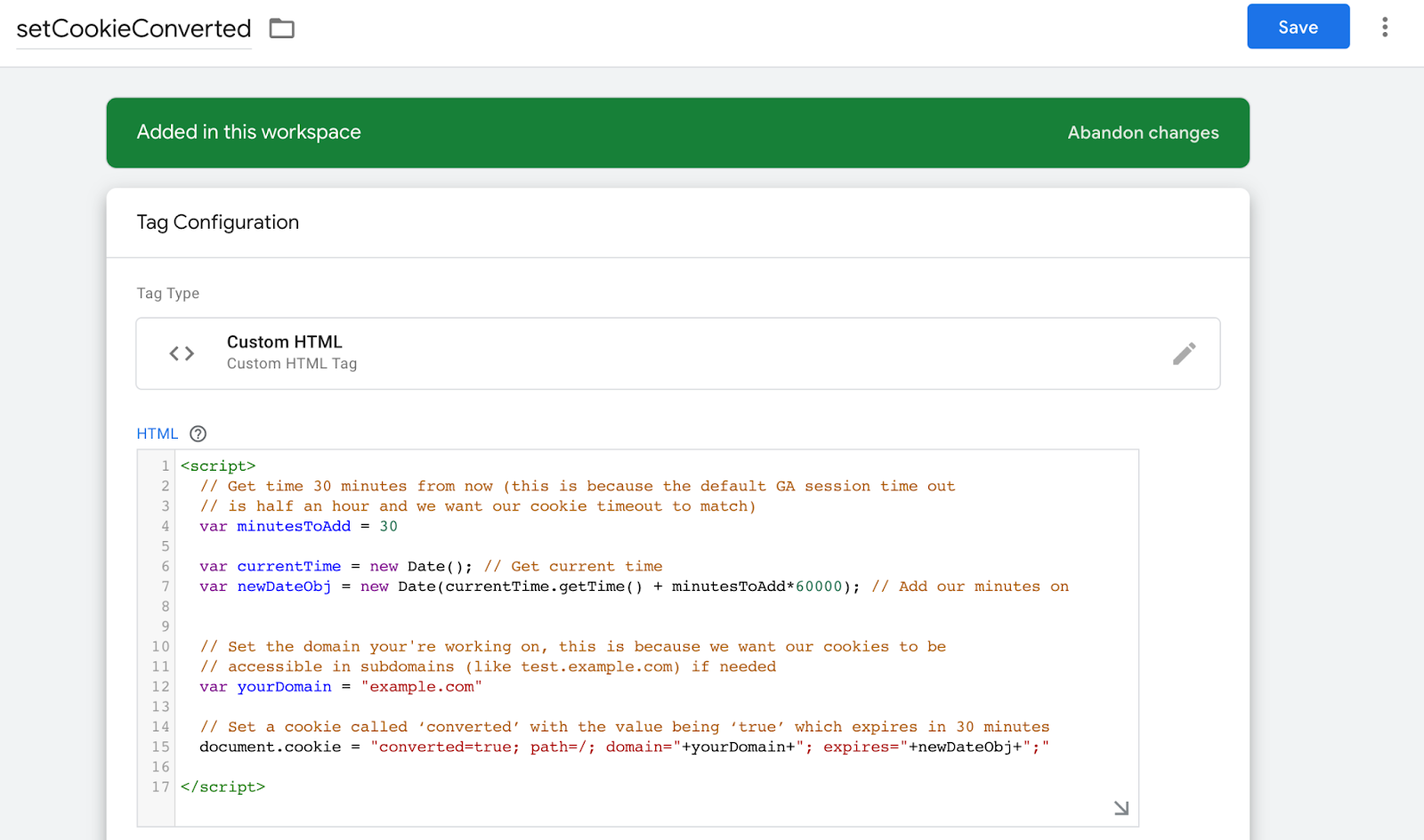
The custom HTML tag will add the content there to the page, and as soon as the page detects a new script (the one we’ve written) it’ll run that script.
What our script does is:
-
It finds the current time, and what time it’ll be in half an hour.
-
It uses that, and your domain, to set a cookie called “converted” which can be read by any page on your website.
When you go to save your tag it’ll probably say “No Triggers Selected”.

For now we’re going to click “Add trigger” and choose the “All Pages” trigger.

This is purely so that while we’re putting this together we can easily test it..
Reading our cookie value
Tag Manager has a built-in way to read cookie values using variables. So go to the variables section, create a new variable called “convertedCookie” and set the Cookie Name as “converted”.
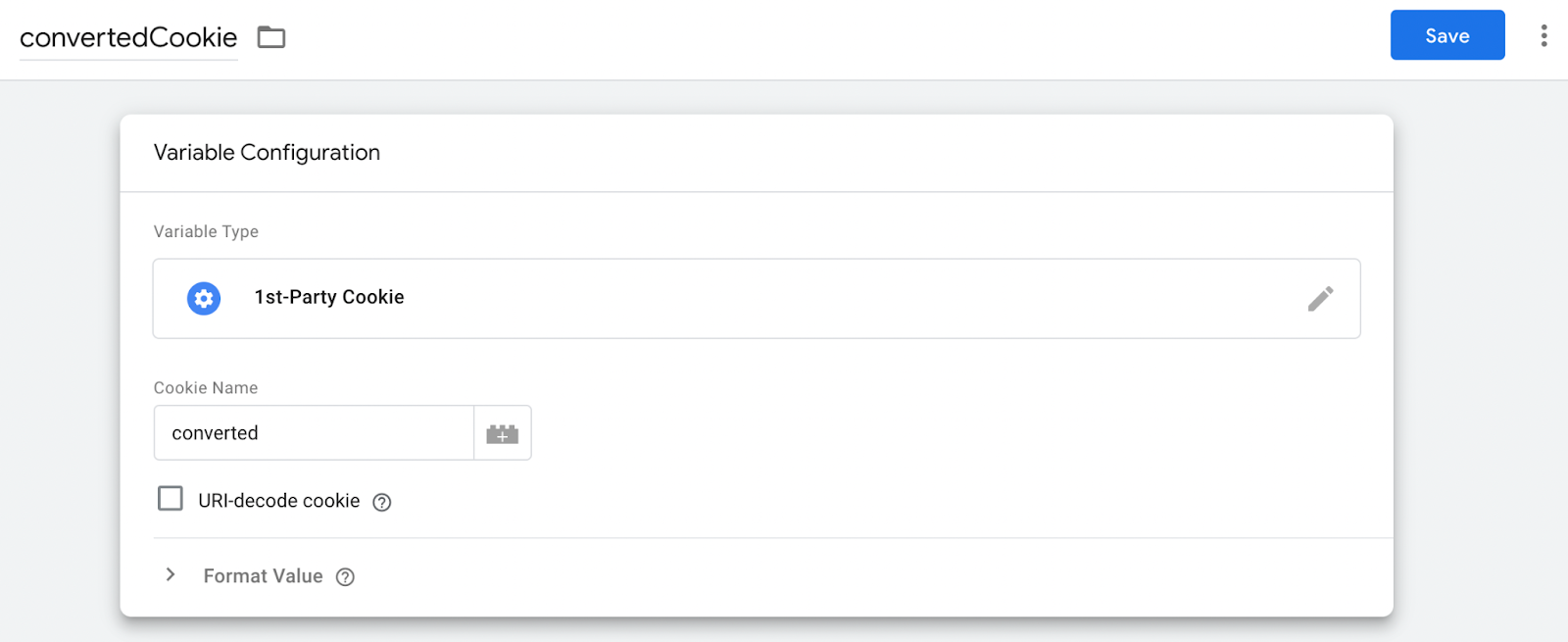
Now, if you click the “Preview” button and open up your site we can start to look at what value the convertedCookie variable pulls through for you.
Click into the “Variables” tab and you should see convertedCookie somewhere in the list. Here’s an example with other cookies blocked out so you know what to look for.
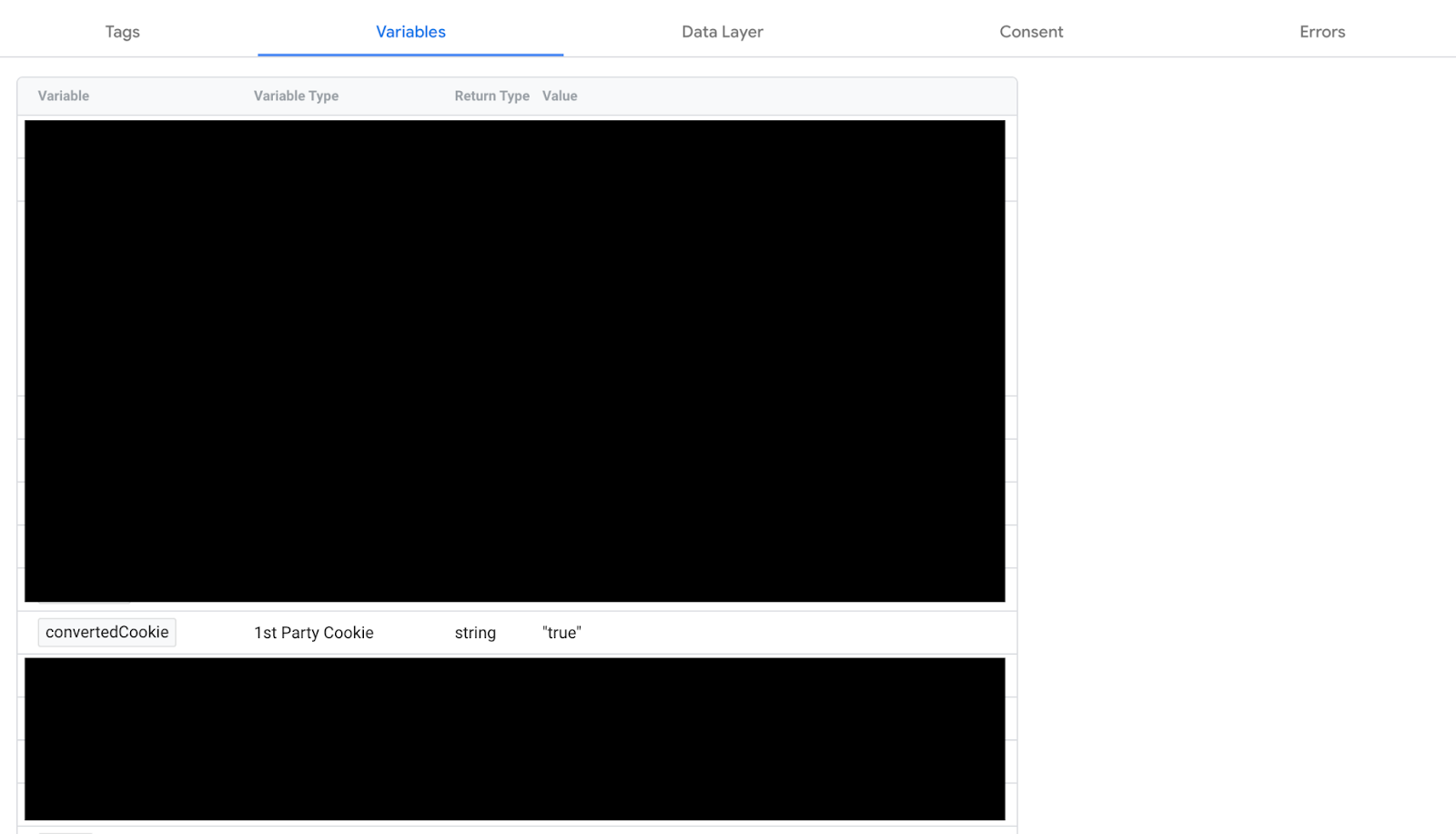
So now we can use the value of that variable in Tag Manager as part of our logic.
Using conversion cookie in our conversion logic
Everyone’s conversion setup will be the different so this might not match what you’re doing exactly but if you’re considering using GTM I’m assuming you are firing conversions something like this:
-
You have a trigger based on some condition (probably either a custom event or a pageview)
-
You have a tag (or multiple tags) that send your conversion information whenever that trigger is activated.
What we’re going to do is tweak your trigger to add another condition.
Imagine that your trigger was previously firing on every thank-you page visit:

What we’re going to do is add a second condition to the trigger:
convertedCookie does not contain true
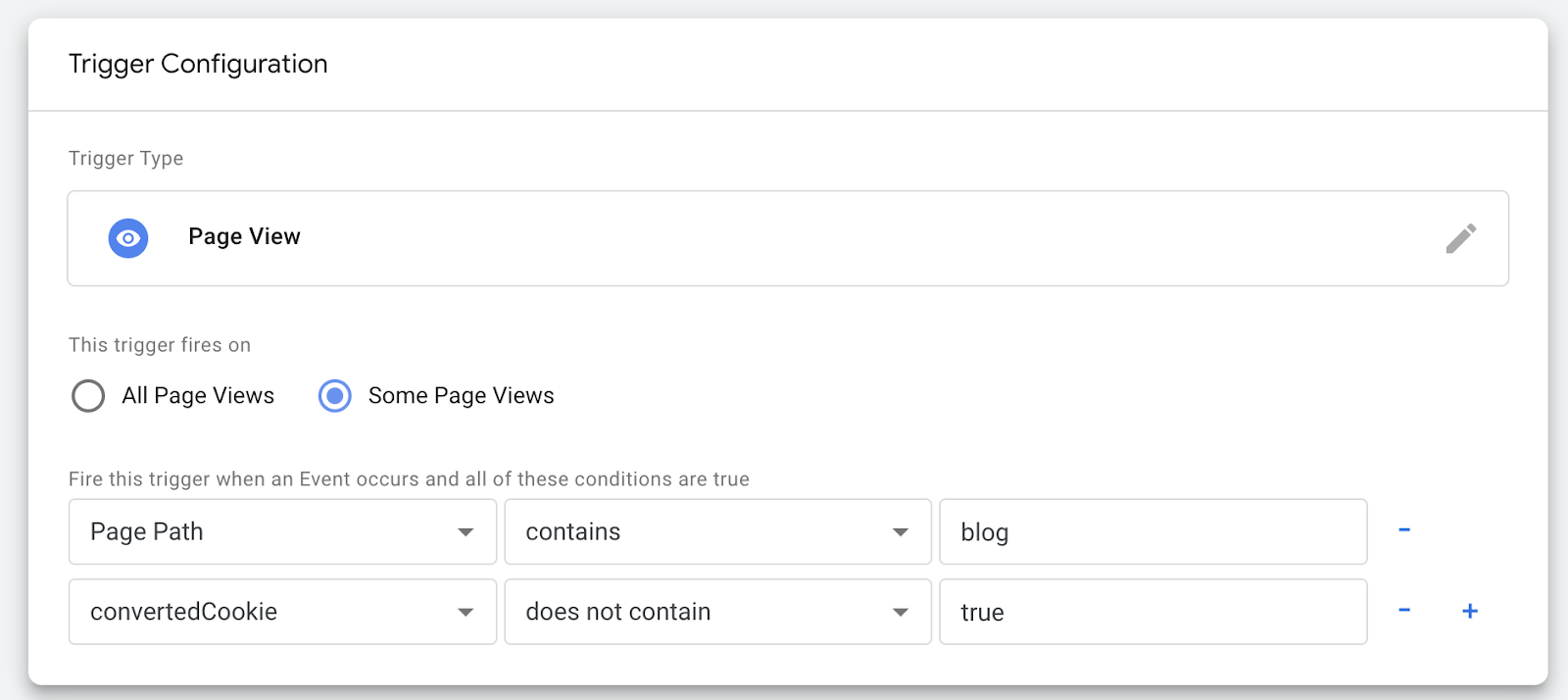
While this example uses the thank you page path, it doesn’t have to, it can be anything.
Once you make this change, you can go and test your conversion. Because you have another tag adding the converted cookie on each page view, your conversion shouldn’t fire when it normally would.
Now we just need to change our converted cookie so that it only appears after someone has converted.
At the moment we’re setting the “converted” cookie on every page view, so we’ll never get any conversions.
We need to update that so:
-
We set a cookie when someone converts.
-
Every time we load a page, if the person is marked as “converted” we reset the cookie (I‘ll explain).
Setting a cookie only when someone has converted
First: we need to remove the trigger from [Tag] setCookieConverted so it doesn’t fire at all.
Then we go to whatever tag we’re using to send our conversion, open up “Advanced Settings”, click “Tag Sequencing” and select “Fire a tag after”.
Then we select our setCookieConverted tag and check “Don’t fire if conversion tag fails”.
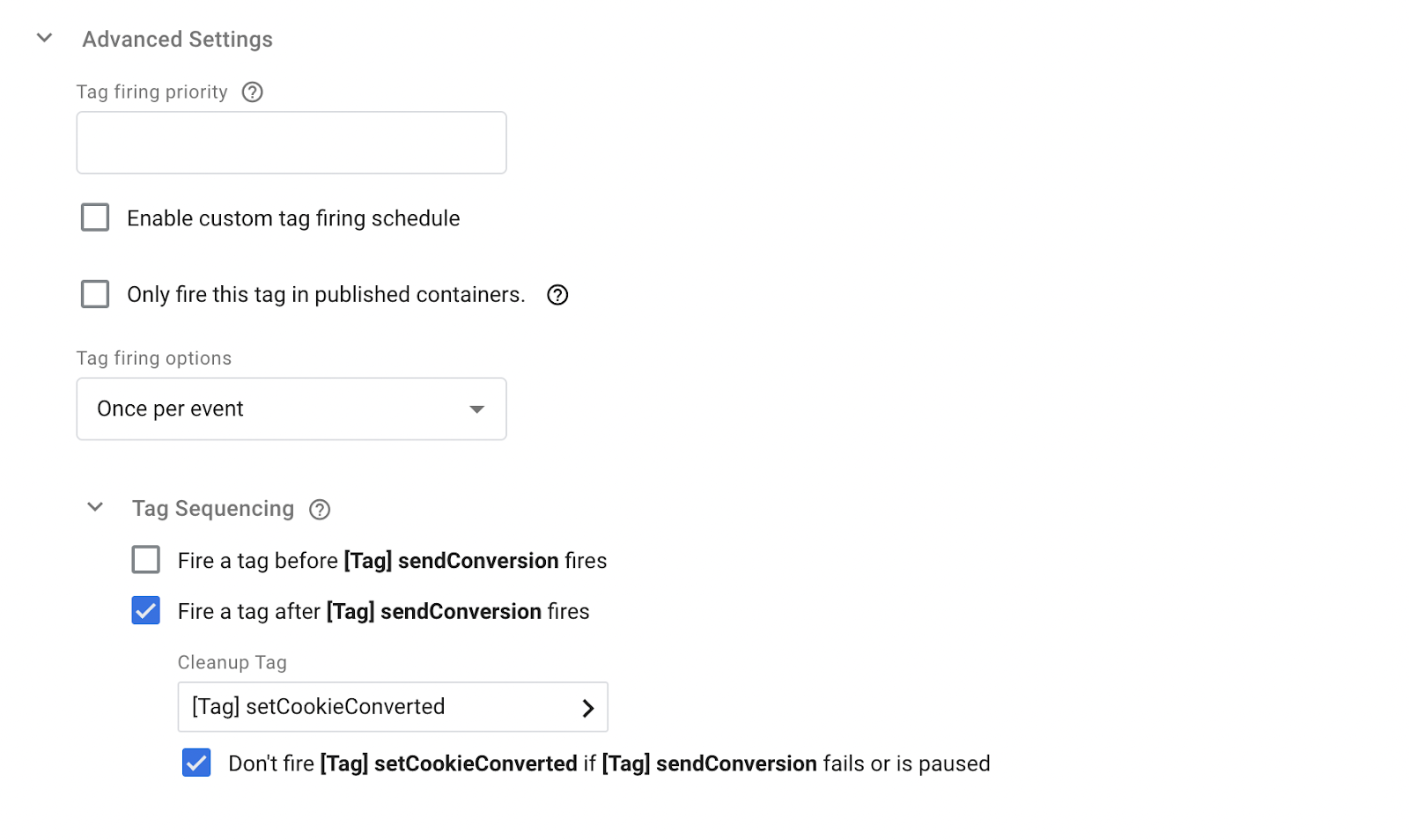
This should mean that whenever we send our conversion, we’ll automatically then activate our cookie tag and mark the user as converted.
So now our logic is:
-
If someone converts, we check if there is a cookie saying they recently converted already.
-
If they don’t have that cookie we send a conversion.
-
Then we automatically set that cookie.
To test this, you can either clear the cookie or wait for it to expire. Here are instructions for how to clear cookies in Google Chrome (which you’re probably using if you’re working with tag manager).
Now, if you got into GTM preview and click around you should be able to look at your variables and see that convertedCookie is back to being ‘undefined’.
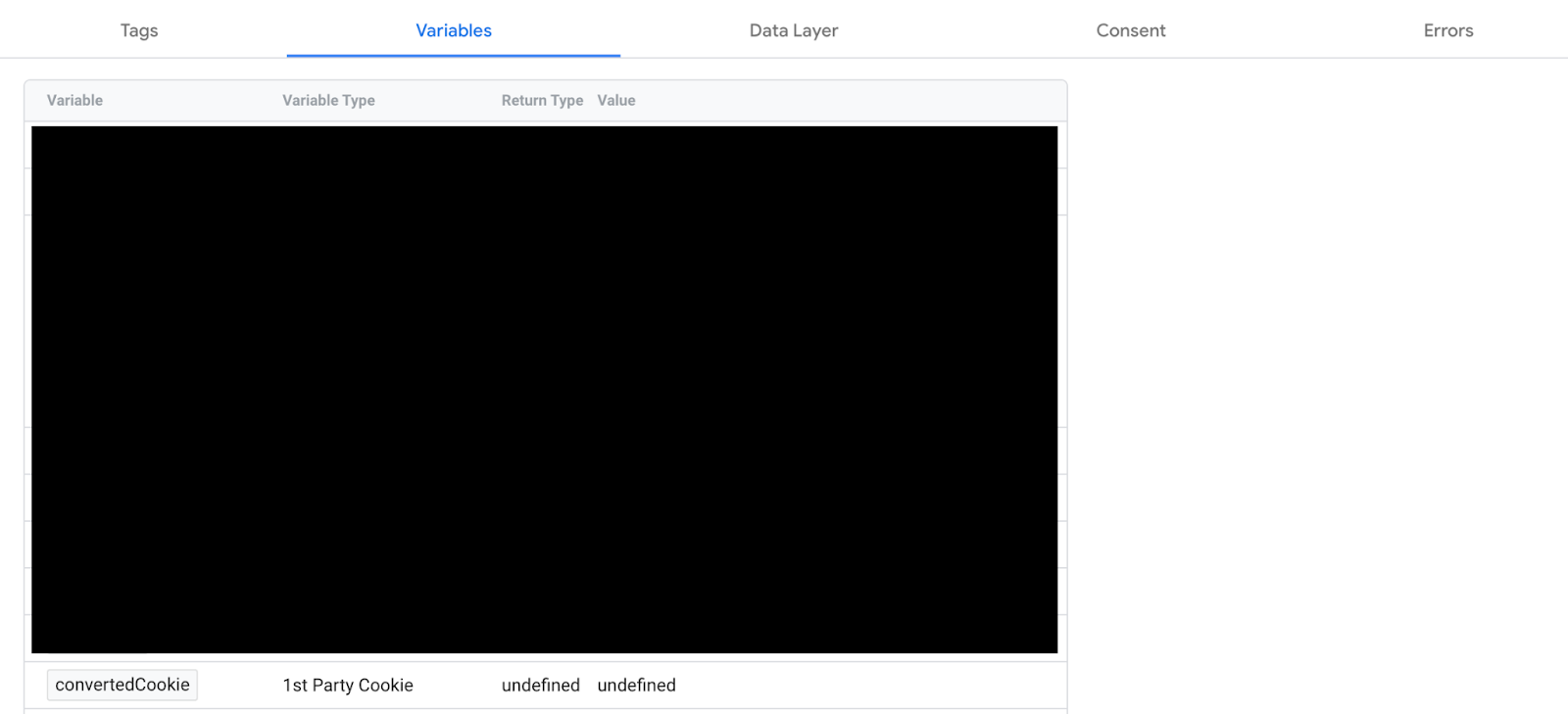
If you convert, you should see that both tags fire — your conversion tag and your setCookieConverted tag.

But if you convert again (reload the page, re-fill the form, whatever you’ve got to do) you should see that neither tag fires.
Congratulations! You’re filtering your conversions to avoid recording a conversion more than once for someone in a 30 minute window.
We just want to make one last tweak now.
Refreshing the cookie if it has been set
Our cookie has a 30 minute expiration. That means it’ll stick around for 30 minutes and then automatically be deleted from the browser. But what if someone hangs around on our website for more than half an hour, reading a blog post or something, and converts again?
To help deal with that, we’re going to add another trigger which checks if the user has recently converted, and if they have, refreshes the cookie with each new page load.
Head back to [Tag] setCookieConverted
At this point it should have no firing triggers. We’re going to add one back in.

Click the blue plus sign in this screen, and again in the next screen that comes up, we’re going to create a new trigger.
In the new trigger, we set it to fire only on page views where convertedCookie contains true.
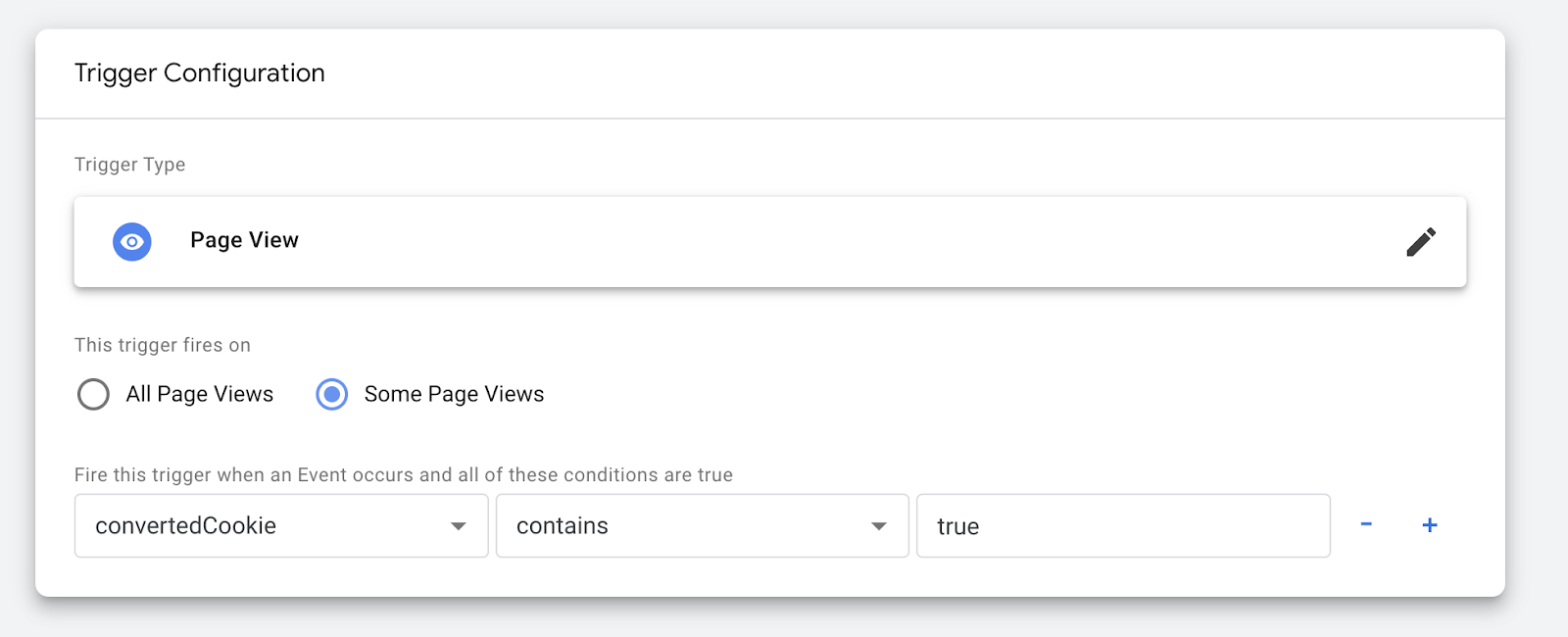
So this gets a little bit circular, but basically:
-
When someone converts we set a “converted” cookie for the next half hour.
-
Every time someone loads a page, if they have a “converted” cookie we reset that cookie for another 30 minutes.
-
If at any point the user doesn’t load a new page for 30 minutes, the cookie will expire, which means our refresh won’t be triggered.
You can test this by clicking around your site with the GTM preview. Once you’ve converted, the [Tag] setCookieConverted should fire on every new page load.
Wrapping up
All you need to do now is make sure that all of your conversion tags use that same trigger (the one that has the condition that convertedCookie isn’t “true”). Once that’s set up, they should all behave the same — only recording one conversion per session unless someone clears their cookies or just hangs around on one page for a very long time.
What if we find we’re getting weird conversions where users haven’t visited any other pages on the site?
I have worked with sites in the past where:
-
There’s useful information on the thank-you page and users have been keeping it open/coming back to it.
-
Confirmation pages have been indexed in Google or people are finding their way to the conversion page some other way.
That can lead to weird tracked conversions that don’t correspond to actual conversions. While these problems should be solved at source, we can also clear up our analytics using the steps in “Creating a conversion funnel” below.
Creating a conversion funnel
This builds on the cookie meddling we’ve done in the last section, so if you haven’t read that bit, it’s worth taking a look!
If you’re here not because you want a specific funnel but because you want to deal with weird conversions where users just land straight on the conversion page – don’t worry you follow these instructions exactly the same, you just set the trigger for every page except your conversion page (I’ll take you through that).
Setting a “path” cookie
Just like the “converted” cookie before, we’re going to create a new cookie that records the location of the current page.
Create a new Tag called [Tag] setCookiePath, choose “Custom HTML” and add the following JavaScript
<script>
// Get time 30 minutes from now (this is because the default GA session time out
// is half an hour and we want our cookie timeout to match)
var minutesToAdd = 30
var currentTime = new Date(); // Get current time
var newDateObj = new Date(currentTime.getTime() + minutesToAdd*60000); // Add our minutes on
// Set the domain your’re working on, this is because we want our cookies to be
// accessible in subdomains (like test.example.com) if needed
var yourDomain = “therobinlord.com”
var pagePathName = window.location.pathname // Get location of current page
// Set a cookie called ‘converted’ with the value being ‘true’ which expires in 30 minutes
document.cookie = “conversionPath=”+location+”; path=/; domain=”+yourDomain+”; expires=”+newDateObj+”;”
</script>
It should look like this:

This will save a cookie that records the location of the page. The first time it’s loaded it will create a new cookie with that information, every time after it’ll replace the value.
We’ll use this to make sure that whichever funnel page our user interacted with last is the one we record.
Triggering on your funnel pages
In creating our “funnel” we’re assuming that there are certain pages a user passes through in order to convert. So we’re going to set this to trigger only when one of those funnel pages is involved.
In your [Tag] setCookiePath tag – click to add a new trigger and create a new trigger.
We’re going to configure our tag to activate on every user click. This means that if a user is hopping between different funnel pages, each one will overwrite the cookie as they click around but only the one they interacted with last will be the one that sticks around in the cookie value.
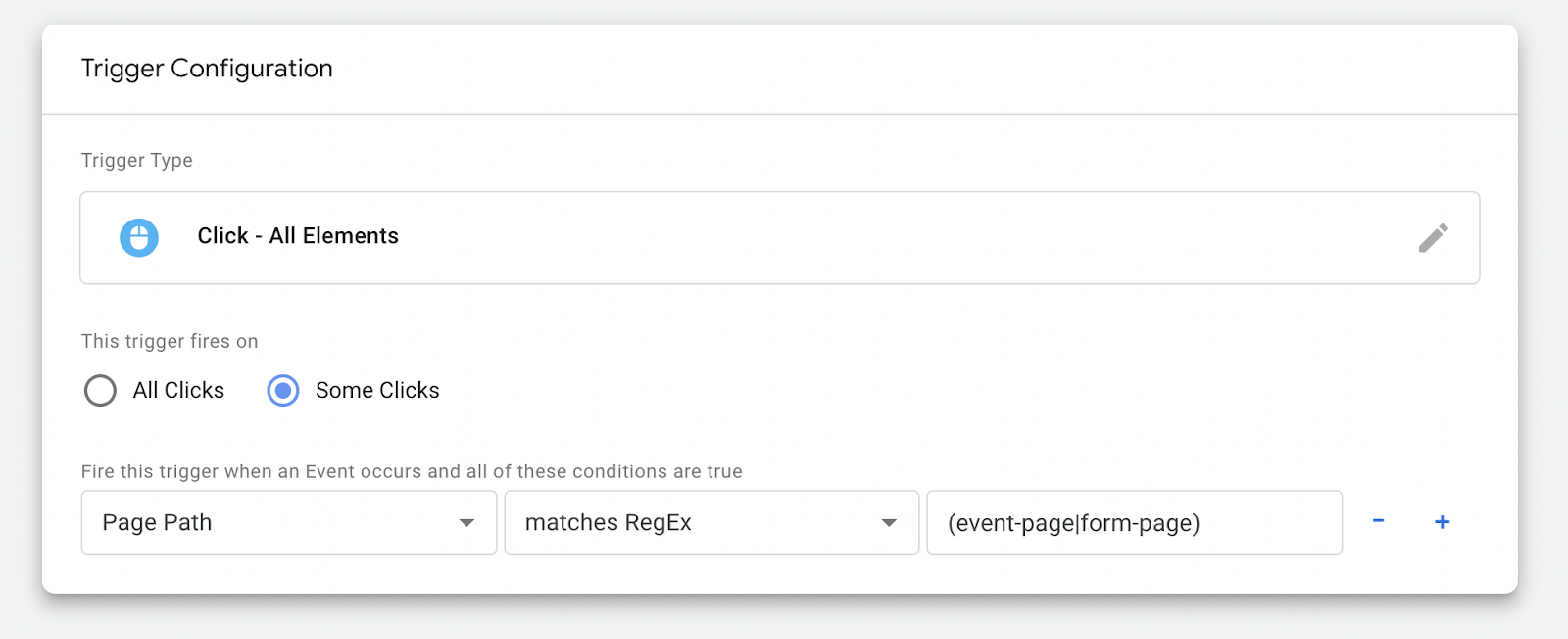
Getting our funnelCookie
As in the double-counting instructions, create a new variable. But this time, call it funnelCookie and set the “Cookie Name” to conversionPath.

Once you’ve done that you should be able to test by using preview, going to any old page of your site (as long as it’s not one of your funnel pages) and checking funnelCookie in the Variables (it should be undefined).
Then go to one of your funnel pages, you should be able to see the cookie change.
As you visit other pages on the site, funnelCookie should stay the same, unless you visit another funnel page.
Changing our conversions based on the funnelCookie
Now, there are smart things you could do here with extracting the value of funnelCookie and putting that into a variable in your conversion tag but the setup for every tag will be different and I want to give you an option for if you’re not able to do that.
This will create a little bit more mess in your Tag Manager account because you’ll be duplicating some of your trigger and conversion tags.
First, let’s go back to the conversion trigger we were working on before. It looked like this when we left it:

We’re going to add in another condition:
funnelCookie contains event-page
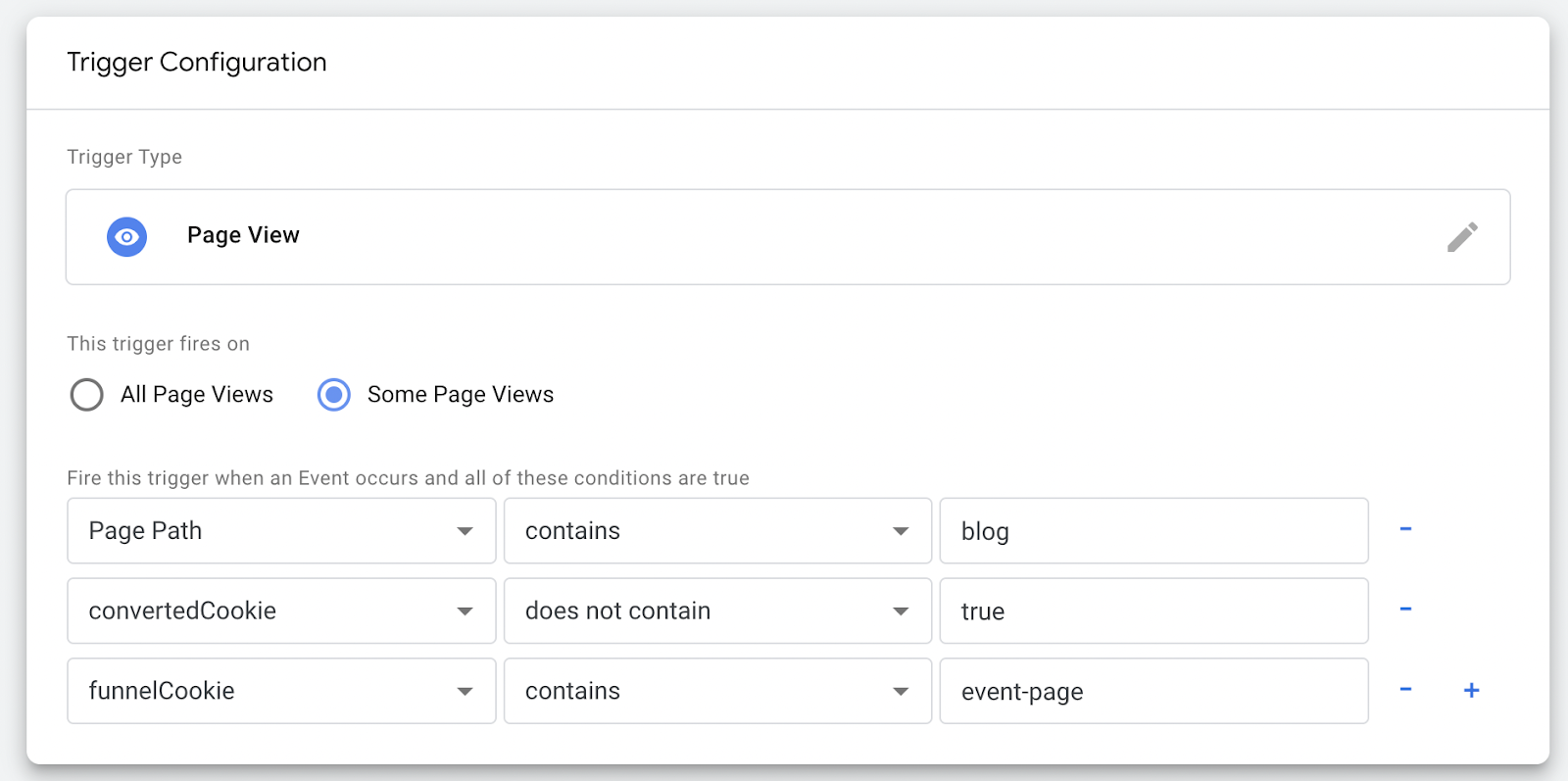
This means now that this conversion will only fire if the last funnel page our user passed through was the event-page.
After this we can duplicate this trigger, our conversion tags, and, for our other set of conversions, change the funnelCookie value for the trigger.
Maybe instead we make it:
funnelCookiecontains form-page
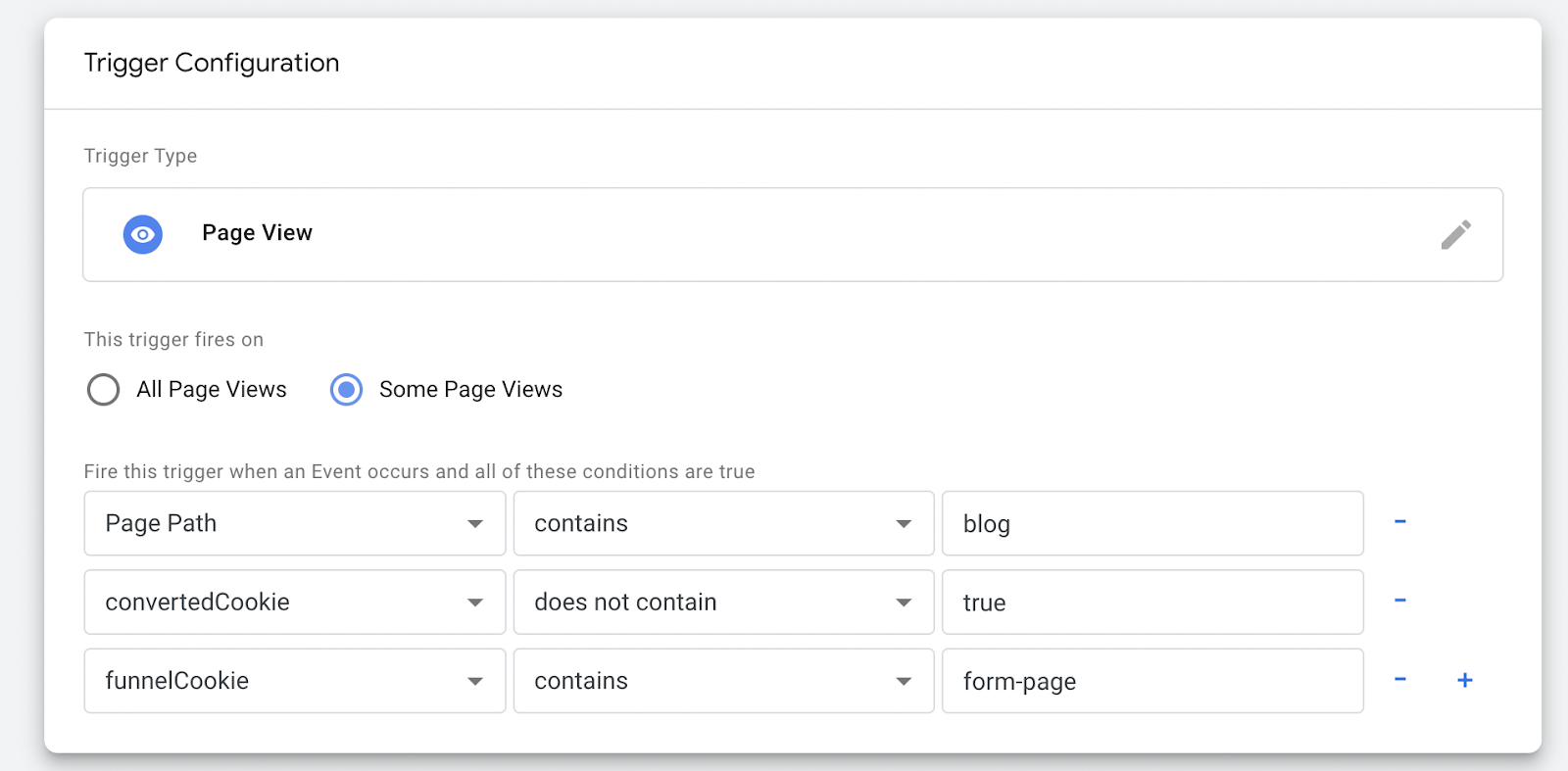
Now you have two sets of conversions, each of which will fire based on which funnel page the user passed through. From there you can edit the values sent.
A couple caveats
Instead of duplicating our conversion tags it would be much better to pull in the value of the funnelCookie variable and use that to just dynamically change some of the values we’re sending as part of the conversion.
With this approach, you also run the risk of not recording any conversions at all if a user hasn’t passed through one of your funnel pages. That might be what you want, but it’s worth bearing that risk in mind in case you think people might take legitimate-but-unusual routes to conversion.
While I can’t take you through the process of updating all of your conversion tags, one option to make this information more ready for filling out conversion tags (and to optionally set a fallback in case you want to avoid losing conversions) is to use a lookup table like this, where you take the funnelCookie value and categorise the values.
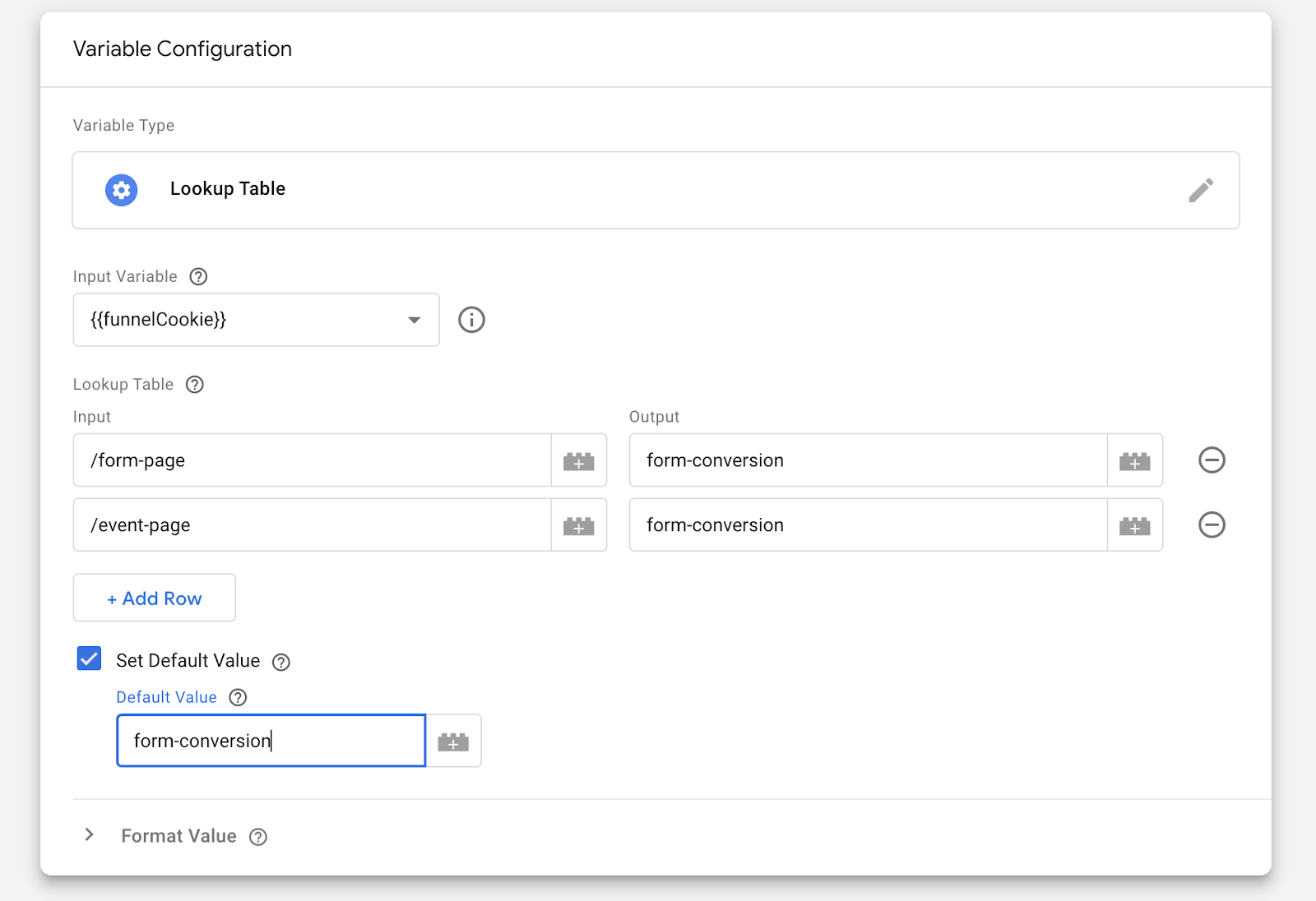
Then instead of adding the funnelCookie value in your trigger, you keep the trigger the same and pull in the lookup table value.
Triggering on any page except your conversion page
If you’re not concerned about constructing page funnels but you want to make sure that users have visited at least one page before converting. There are a couple changes:
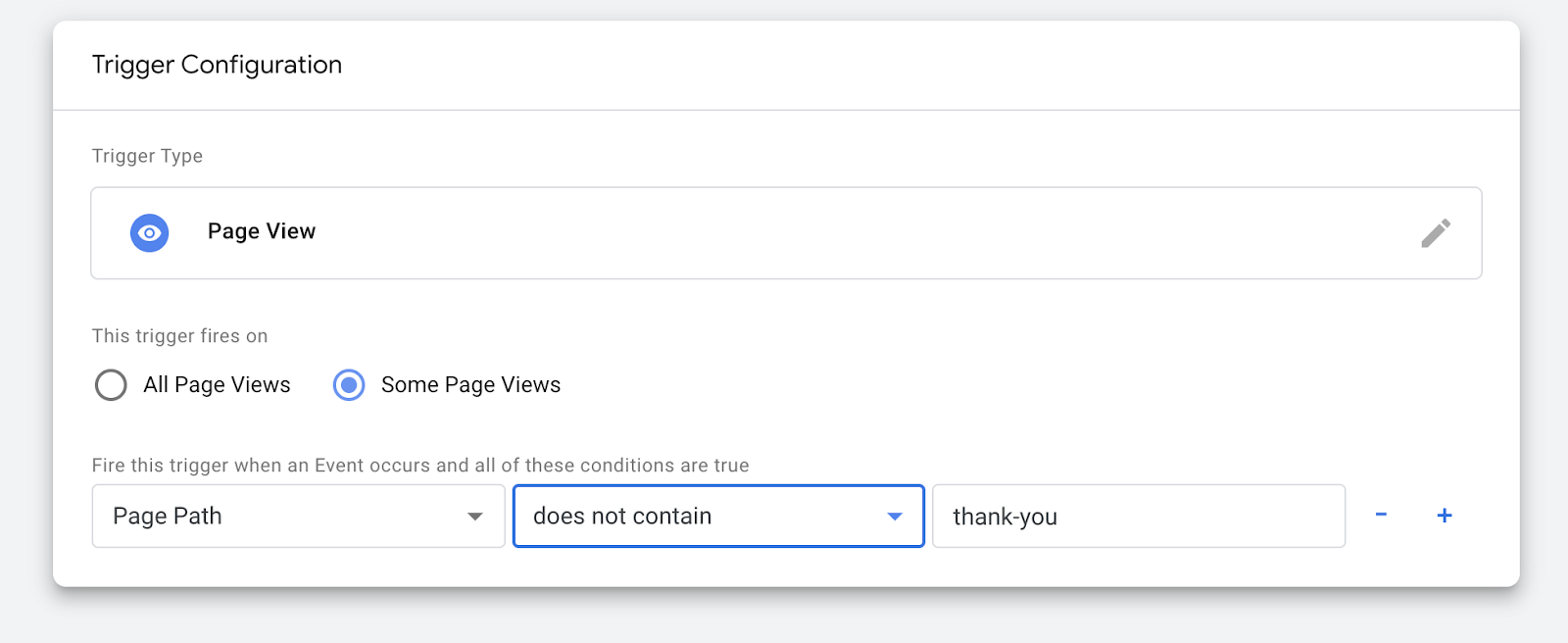
-
You don’t bother creating different conversion flows, you just have one flow, but you still add a funnelCookie requirement which says that your funnelCookie has to be some page rather than undefined
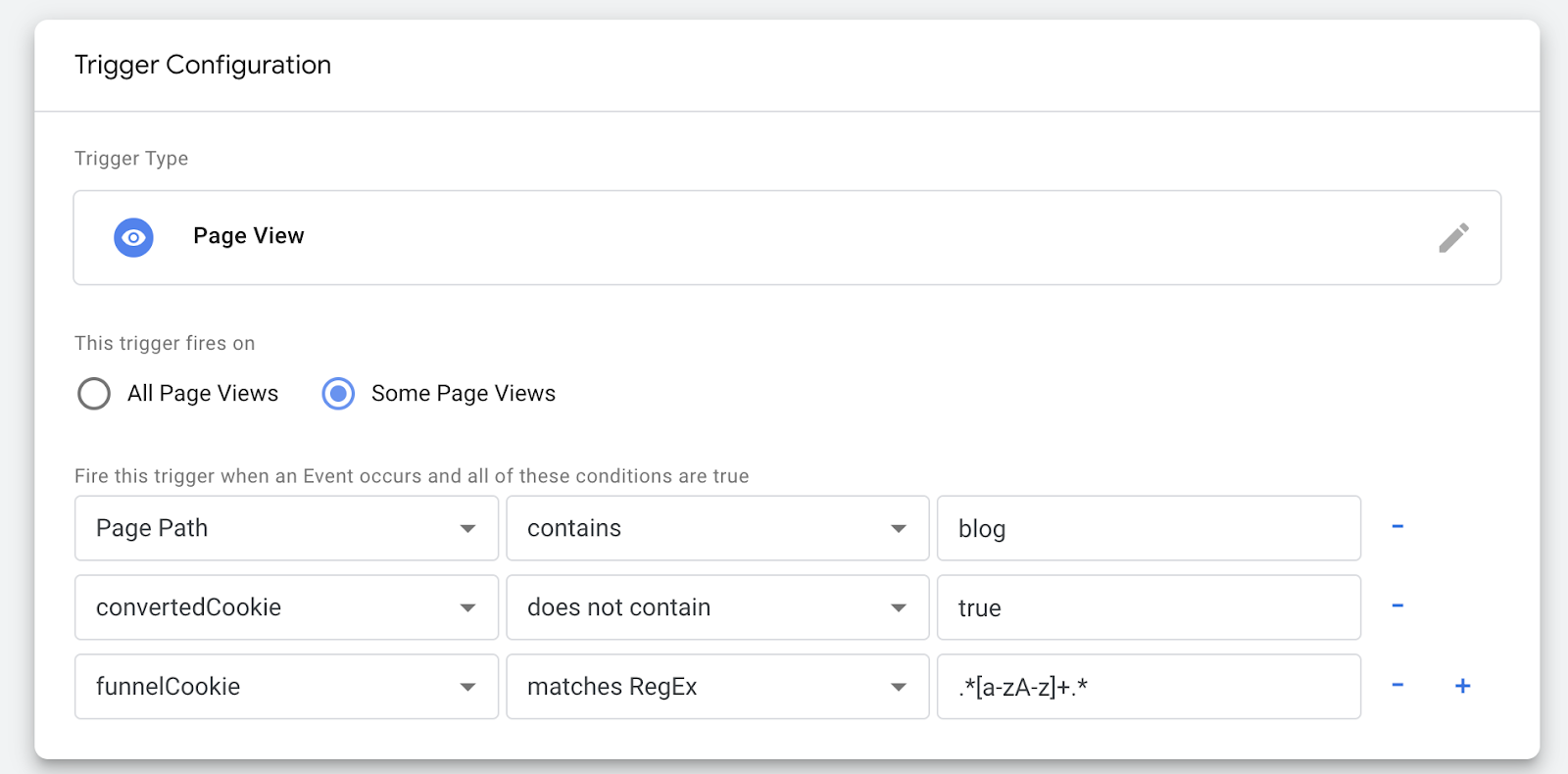
Conclusion
Hopefully this has helped you get an idea of how to get more control of the conversions being recorded on your site, whether that’s entirely through GA4 or using the power of Tag Manager.
Happy tracking!
MARKETING
Streamlining Processes for Increased Efficiency and Results

How can businesses succeed nowadays when technology rules? With competition getting tougher and customers changing their preferences often, it’s a challenge. But using marketing automation can help make things easier and get better results. And in the future, it’s going to be even more important for all kinds of businesses.
So, let’s discuss how businesses can leverage marketing automation to stay ahead and thrive.
Benefits of automation marketing automation to boost your efforts
First, let’s explore the benefits of marketing automation to supercharge your efforts:
Marketing automation simplifies repetitive tasks, saving time and effort.
With automated workflows, processes become more efficient, leading to better productivity. For instance, automation not only streamlines tasks like email campaigns but also optimizes website speed, ensuring a seamless user experience. A faster website not only enhances customer satisfaction but also positively impacts search engine rankings, driving more organic traffic and ultimately boosting conversions.
Automation allows for precise targeting, reaching the right audience with personalized messages.
With automated workflows, processes become more efficient, leading to better productivity. A great example of automated workflow is Pipedrive & WhatsApp Integration in which an automated welcome message pops up on their WhatsApp
within seconds once a potential customer expresses interest in your business.
Increases ROI
By optimizing campaigns and reducing manual labor, automation can significantly improve return on investment.
Leveraging automation enables businesses to scale their marketing efforts effectively, driving growth and success. Additionally, incorporating lead scoring into automated marketing processes can streamline the identification of high-potential prospects, further optimizing resource allocation and maximizing conversion rates.
Harnessing the power of marketing automation can revolutionize your marketing strategy, leading to increased efficiency, higher returns, and sustainable growth in today’s competitive market. So, why wait? Start automating your marketing efforts today and propel your business to new heights, moreover if you have just learned ways on how to create an online business
How marketing automation can simplify operations and increase efficiency
Understanding the Change
Marketing automation has evolved significantly over time, from basic email marketing campaigns to sophisticated platforms that can manage entire marketing strategies. This progress has been fueled by advances in technology, particularly artificial intelligence (AI) and machine learning, making automation smarter and more adaptable.
One of the main reasons for this shift is the vast amount of data available to marketers today. From understanding customer demographics to analyzing behavior, the sheer volume of data is staggering. Marketing automation platforms use this data to create highly personalized and targeted campaigns, allowing businesses to connect with their audience on a deeper level.
The Emergence of AI-Powered Automation
In the future, AI-powered automation will play an even bigger role in marketing strategies. AI algorithms can analyze huge amounts of data in real-time, helping marketers identify trends, predict consumer behavior, and optimize campaigns as they go. This agility and responsiveness are crucial in today’s fast-moving digital world, where opportunities come and go in the blink of an eye. For example, we’re witnessing the rise of AI-based tools from AI website builders, to AI logo generators and even more, showing that we’re competing with time and efficiency.
Combining AI-powered automation with WordPress management services streamlines marketing efforts, enabling quick adaptation to changing trends and efficient management of online presence.
Moreover, AI can take care of routine tasks like content creation, scheduling, and testing, giving marketers more time to focus on strategic activities. By automating these repetitive tasks, businesses can work more efficiently, leading to better outcomes. AI can create social media ads tailored to specific demographics and preferences, ensuring that the content resonates with the target audience. With the help of an AI ad maker tool, businesses can efficiently produce high-quality advertisements that drive engagement and conversions across various social media platforms.
Personalization on a Large Scale
Personalization has always been important in marketing, and automation is making it possible on a larger scale. By using AI and machine learning, marketers can create tailored experiences for each customer based on their preferences, behaviors, and past interactions with the brand.
This level of personalization not only boosts customer satisfaction but also increases engagement and loyalty. When consumers feel understood and valued, they are more likely to become loyal customers and brand advocates. As automation technology continues to evolve, we can expect personalization to become even more advanced, enabling businesses to forge deeper connections with their audience. As your company has tiny homes for sale California, personalized experiences will ensure each customer finds their perfect fit, fostering lasting connections.
Integration Across Channels
Another trend shaping the future of marketing automation is the integration of multiple channels into a cohesive strategy. Today’s consumers interact with brands across various touchpoints, from social media and email to websites and mobile apps. Marketing automation platforms that can seamlessly integrate these channels and deliver consistent messaging will have a competitive edge. When creating a comparison website it’s important to ensure that the platform effectively aggregates data from diverse sources and presents it in a user-friendly manner, empowering consumers to make informed decisions.
Omni-channel integration not only betters the customer experience but also provides marketers with a comprehensive view of the customer journey. By tracking interactions across channels, businesses can gain valuable insights into how consumers engage with their brand, allowing them to refine their marketing strategies for maximum impact. Lastly, integrating SEO services into omni-channel strategies boosts visibility and helps businesses better understand and engage with their customers across different platforms.
The Human Element
While automation offers many benefits, it’s crucial not to overlook the human aspect of marketing. Despite advances in AI and machine learning, there are still elements of marketing that require human creativity, empathy, and strategic thinking.
Successful marketing automation strikes a balance between technology and human expertise. By using automation to handle routine tasks and data analysis, marketers can focus on what they do best – storytelling, building relationships, and driving innovation.
Conclusion
The future of marketing automation looks promising, offering improved efficiency and results for businesses of all sizes.
As AI continues to advance and consumer expectations change, automation will play an increasingly vital role in keeping businesses competitive.
By embracing automation technologies, marketers can simplify processes, deliver more personalized experiences, and ultimately, achieve their business goals more effectively than ever before.
MARKETING
Will Google Buy HubSpot? | Content Marketing Institute

Google + HubSpot. Is it a thing?
This week, a flurry of news came down about Google’s consideration of purchasing HubSpot.
The prospect dismayed some. It delighted others.
But is it likely? Is it even possible? What would it mean for marketers? What does the consideration even mean for marketers?
Well, we asked CMI’s chief strategy advisor, Robert Rose, for his take. Watch this video or read on:
Why Alphabet may want HubSpot
Alphabet, the parent company of Google, apparently is contemplating the acquisition of inbound marketing giant HubSpot.
The potential price could be in the range of $30 billion to $40 billion. That would make Alphabet’s largest acquisition by far. The current deal holding that title happened in 2011 when it acquired Motorola Mobility for more than $12 billion. It later sold it to Lenovo for less than $3 billion.
If the HubSpot deal happens, it would not be in character with what the classic evil villain has been doing for the past 20 years.
At first glance, you might think the deal would make no sense. Why would Google want to spend three times as much as it’s ever spent to get into the inbound marketing — the CRM and marketing automation business?
At a second glance, it makes a ton of sense.
I don’t know if you’ve noticed, but I and others at CMI spend a lot of time discussing privacy, owned media, and the deprecation of the third-party cookie. I just talked about it two weeks ago. It’s really happening.
All that oxygen being sucked out of the ad tech space presents a compelling case that Alphabet should diversify from third-party data and classic surveillance-based marketing.
Yes, this potential acquisition is about data. HubSpot would give Alphabet the keys to the kingdom of 205,000 business customers — and their customers’ data that almost certainly numbers in the tens of millions. Alphabet would also gain access to the content, marketing, and sales information those customers consumed.
Conversely, the deal would provide an immediate tip of the spear for HubSpot clients to create more targeted programs in the Alphabet ecosystem and upload their data to drive even more personalized experiences on their own properties and connect them to the Google Workspace infrastructure.
When you add in the idea of Gemini, you can start to see how Google might monetize its generative AI tool beyond figuring out how to use it on ads on search results pages.
What acquisition could mean for HubSpot customers
I may be stretching here but imagine this world. As a Hubspoogle customer, you can access an interface that prioritizes your owned media data (e.g., your website, your e-commerce catalog, blog) when Google’s Gemini answers a question).
Recent reports also say Google may put up a paywall around the new premium features of its artificial intelligence-powered Search Generative Experience. Imagine this as the new gating for marketing. In other words, users can subscribe to Google’s AI for free, but Hubspoogle customers can access that data and use it to create targeted offers.
The acquisition of HubSpot would immediately make Google Workspace a more robust competitor to Microsoft 365 Office for small- and medium-sized businesses as they would receive the ADDED capability of inbound marketing.
But in the world of rented land where Google is the landlord, the government will take notice of the acquisition. But — and it’s a big but, I cannot lie (yes, I just did that). The big but is whether this acquisition dance can happen without going afoul of regulatory issues.
Some analysts say it should be no problem. Others say, “Yeah, it wouldn’t go.” Either way, would anybody touch it in an election year? That’s a whole other story.
What marketers should realize
So, what’s my takeaway?
It’s a remote chance that Google will jump on this hard, but stranger things have happened. It would be an exciting disruption in the market.
The sure bet is this. The acquisition conversation — as if you needed more data points — says getting good at owned media to attract and build audiences and using that first-party data to provide better communication and collaboration with your customers are a must.
It’s just a matter of time until Google makes a move. They might just be testing the waters now, but they will move here. But no matter what they do, if you have your customer data house in order, you’ll be primed for success.
HANDPICKED RELATED CONTENT:
Cover image by Joseph Kalinowski/Content Marketing Institute
MARKETING
5 Psychological Tactics to Write Better Emails

Welcome to Creator Columns, where we bring expert HubSpot Creator voices to the Blogs that inspire and help you grow better.
I’ve tested 100s of psychological tactics on my email subscribers. In this blog, I reveal the five tactics that actually work.
You’ll learn about the email tactic that got one marketer a job at the White House.
You’ll learn how I doubled my 5 star reviews with one email, and why one strange email from Barack Obama broke all records for donations.
5 Psychological Tactics to Write Better Emails
Imagine writing an email that’s so effective it lands you a job at the White House.
Well, that’s what happened to Maya Shankar, a PhD cognitive neuroscientist. In 2014, the Department of Veterans Affairs asked her to help increase signups in their veteran benefit scheme.
Maya had a plan. She was well aware of a cognitive bias that affects us all—the endowment effect. This bias suggests that people value items higher if they own them. So, she changed the subject line in the Veterans’ enrollment email.
Previously it read:
- Veterans, you’re eligible for the benefit program. Sign up today.
She tweaked one word, changing it to:
- Veterans, you’ve earned the benefits program. Sign up today.
This tiny tweak had a big impact. The amount of veterans enrolling in the program went up by 9%. And Maya landed a job working at the White House

Inspired by these psychological tweaks to emails, I started to run my own tests.
Alongside my podcast Nudge, I’ve run 100s of email tests on my 1,000s of newsletter subscribers.
Here are the five best tactics I’ve uncovered.
1. Show readers what they’re missing.
Nobel prize winning behavioral scientists Daniel Kahneman and Amos Tversky uncovered a principle called loss aversion.
Loss aversion means that losses feel more painful than equivalent gains. In real-world terms, losing $10 feels worse than how gaining $10 feels good. And I wondered if this simple nudge could help increase the number of my podcast listeners.
For my test, I tweaked the subject line of the email announcing an episode. The control read:
“Listen to this one”
In the loss aversion variant it read:
“Don’t miss this one”
It is very subtle loss aversion. Rather than asking someone to listen, I’m saying they shouldn’t miss out. And it worked. It increased the open rate by 13.3% and the click rate by 12.5%. Plus, it was a small change that cost me nothing at all.

2. People follow the crowd.
In general, humans like to follow the masses. When picking a dish, we’ll often opt for the most popular. When choosing a movie to watch, we tend to pick the box office hit. It’s a well-known psychological bias called social proof.
I’ve always wondered if it works for emails. So, I set up an A/B experiment with two subject lines. Both promoted my show, but one contained social proof.
The control read: New Nudge: Why Brands Should Flaunt Their Flaws
The social proof variant read: New Nudge: Why Brands Should Flaunt Their Flaws (100,000 Downloads)
I hoped that by highlighting the episode’s high number of downloads, I’d encourage more people to listen. Fortunately, it worked.
The open rate went from 22% to 28% for the social proof version, and the click rate, (the number of people actually listening to the episode), doubled.
3. Praise loyal subscribers.
The consistency principle suggests that people are likely to stick to behaviours they’ve previously taken. A retired taxi driver won’t swap his car for a bike. A hairdresser won’t change to a cheap shampoo. We like to stay consistent with our past behaviors.
I decided to test this in an email.
For my test, I attempted to encourage my subscribers to leave a review for my podcast. I sent emails to 400 subscribers who had been following the show for a year.
The control read: “Could you leave a review for Nudge?”
The consistency variant read: “You’ve been following Nudge for 12 months, could you leave a review?”
My hypothesis was simple. If I remind people that they’ve consistently supported the show they’ll be more likely to leave a review.
It worked.
The open rate on the consistency version of the email was 7% higher.
But more importantly, the click rate, (the number of people who actually left a review), was almost 2x higher for the consistency version. Merely telling people they’d been a fan for a while doubled my reviews.
4. Showcase scarcity.
We prefer scarce resources. Taylor Swift gigs sell out in seconds not just because she’s popular, but because her tickets are hard to come by.
Swifties aren’t the first to experience this. Back in 1975, three researchers proved how powerful scarcity is. For the study, the researchers occupied a cafe. On alternating weeks they’d make one small change in the cafe.
On some weeks they’d ensure the cookie jar was full.
On other weeks they’d ensure the cookie jar only contained two cookies (never more or less).
In other words, sometimes the cookies looked abundantly available. Sometimes they looked like they were almost out.
This changed behaviour. Customers who saw the two cookie jar bought 43% more cookies than those who saw the full jar.
It sounds too good to be true, so I tested it for myself.
I sent an email to 260 subscribers offering free access to my Science of Marketing course for one day only.
In the control, the subject line read: “Free access to the Science of Marketing course”
For the scarcity variant it read: “Only Today: Get free access to the Science of Marketing Course | Only one enrol per person.”
130 people received the first email, 130 received the second. And the result was almost as good as the cookie finding. The scarcity version had a 15.1% higher open rate.

5. Spark curiosity.
All of the email tips I’ve shared have only been tested on my relatively small audience. So, I thought I’d end with a tip that was tested on the masses.
Back in 2012, Barack Obama and his campaign team sent hundreds of emails to raise funds for his campaign.
Of the $690 million he raised, most came from direct email appeals. But there was one email, according to ABC news, that was far more effective than the rest. And it was an odd one.
The email that drew in the most cash, had a strange subject line. It simply said “Hey.”
The actual email asked the reader to donate, sharing all the expected reasons, but the subject line was different.
It sparked curiosity, it got people wondering, is Obama saying Hey just to me?
Readers were curious and couldn’t help but open the email. According to ABC it was “the most effective pitch of all.”
Because more people opened, it raised more money than any other email. The bias Obama used here is the curiosity gap. We’re more likely to act on something when our curiosity is piqued.

Loss aversion, social proof, consistency, scarcity and curiosity—all these nudges have helped me improve my emails. And I reckon they’ll work for you.
It’s not guaranteed of course. Many might fail. But running some simple a/b tests for your emails is cost free, so why not try it out?
This blog is part of Phill Agnew’s Marketing Cheat Sheet series where he reveals the scientifically proven tips to help you improve your marketing. To learn more, listen to his podcast Nudge, a proud member of the Hubspot Podcast Network.
-

 WORDPRESS7 days ago
WORDPRESS7 days agoTurkish startup ikas attracts $20M for its e-commerce platform designed for small businesses
-

 MARKETING6 days ago
MARKETING6 days agoRoundel Media Studio: What to Expect From Target’s New Self-Service Platform
-

 SEO5 days ago
SEO5 days agoGoogle Limits News Links In California Over Proposed ‘Link Tax’ Law
-
SEARCHENGINES6 days ago
Daily Search Forum Recap: April 12, 2024
-

 SEARCHENGINES7 days ago
SEARCHENGINES7 days agoGoogle Search Results Can Be Harmful & Dangerous In Some Cases
-

 MARKETING7 days ago
MARKETING7 days agoUnlocking the Power of AI Transcription for Enhanced Content Marketing Strategies
-

 SEO5 days ago
SEO5 days ago10 Paid Search & PPC Planning Best Practices
-

 SEARCHENGINES5 days ago
SEARCHENGINES5 days agoGoogle Core Update Volatility, Helpful Content Update Gone, Dangerous Google Search Results & Google Ads Confusion















![5 Psychological Tactics to Write Better Emails → Download Now: The Beginner's Guide to Email Marketing [Free Ebook]](https://articles.entireweb.com/wp-content/uploads/2023/02/11-Free-Email-Hacks-to-Step-Up-Your-Productivity.png)


